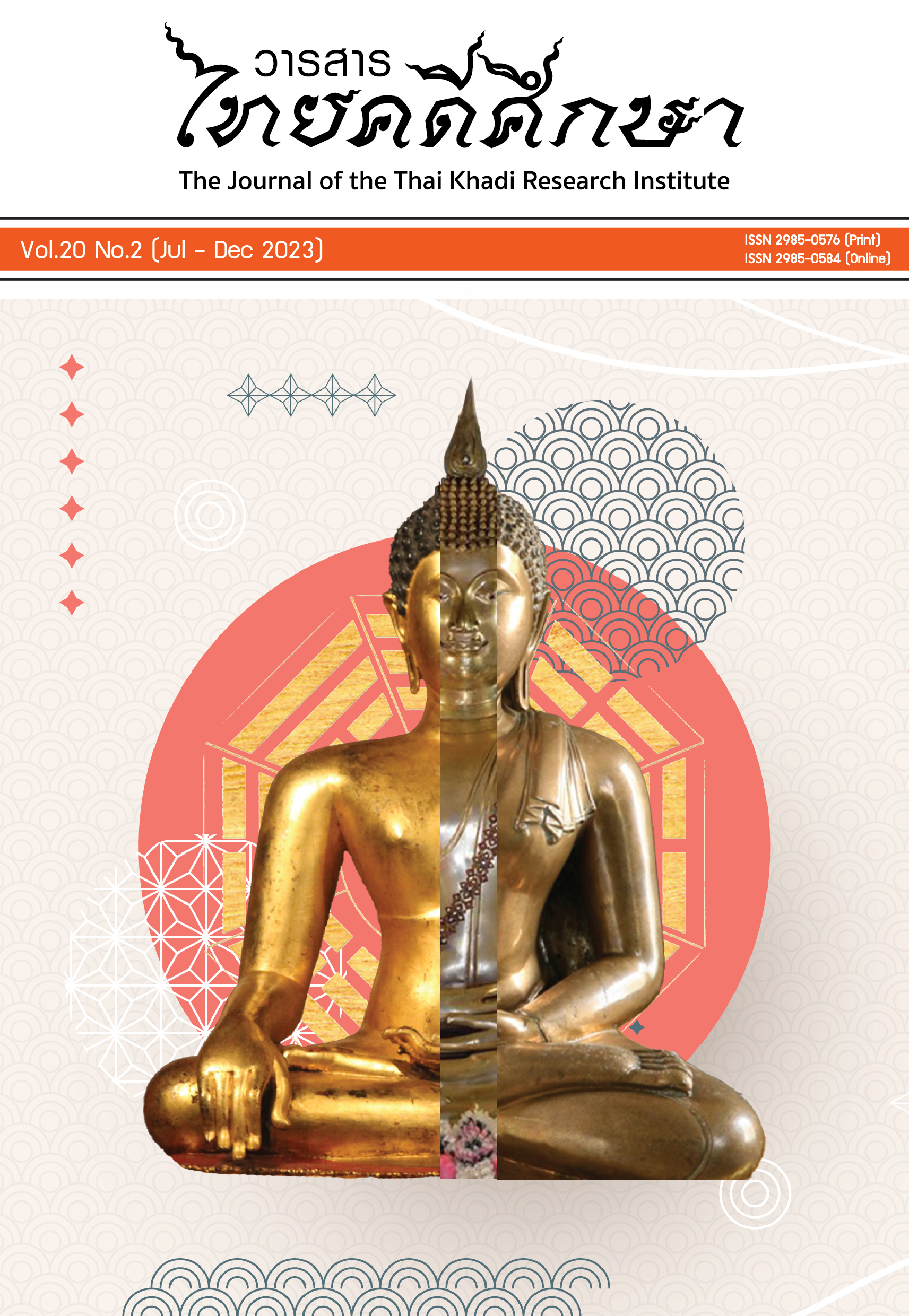ศิลปะและวัฒนธรรมต่างเป็นสิ่งซึ่งมีความสอดประสานกันอย่างใกล้ชิด กล่าวคือเป็นสิ่งที่มนุษย์สร้างขึ้นจากคติ ความเชื่อ ความรู้ความจริงในชีวิต สร้างสรรค์จนเกิดเป็นสิ่งซึ่งเต็มเปี่ยมไปด้วยคุณค่าทางศาสนา ประวัติศาสตร์ การเมืองการปกครอง ตลอดจนคุณค่าทางสุนทรียะ เนื้อหาของวารสารไทยคดีศึกษา ปีที่ 20 ฉบับที่ 2 เล่มนี้ ถือเป็นอีกเล่มหนึ่งที่ทำหน้าที่สะท้อนคุณค่าของศิลปะและวัฒนธรรมที่สะท้อนผ่านปรากฏการณ์ทางสังคมที่โดดเด่นแตกต่างหลากหลายกันออกไป
บทความแรก พระไพรีพินาศ: การแปลงพุทธศิลป์ชวาตามรูปแบบพระราชนิยมในรัชกาลที่ 4 เขียนโดย ศรัณย์ มะกรูดอินทร์ ที่ให้ข้อมูลอย่างละเอียดของพระไพรีพินาศ พระพุทธรูปสำคัญของวัดบวรนิเวศวิหาร ที่พระบาทสมเด็จพระจอมเกล้าเจ้าอยู่หัวทรงได้รับการทูลเกล้าฯ ถวายมาตั้งแต่ครั้งยังทรงพระผนวชครองวัดบวรนิเวศวิหาร พระพุทธรูปองค์นี้มีรูปแบบเหมือนกับพระพุทธรูปที่จันทิกะลาสัน เมืองกลาเตน เกาะชวา ประเทศอินโดนีเซีย ในรูปแบบศิลปะชวาภาคกลางตอนปลาย ผู้เขียนอธิบายพระไพรีพินาศอย่างลุ่มลึกทั้งในมิติของความเป็นมา พุทธศิลป์ ตลอดจนการแปลงพระไพรีพินาศตามแบบพระราชนิยมในรัชกาลที่ 4
บทความถัดมา การผลิตซ้ำตำนานเรื่องเล่าพระพุทธสิหิงค์ - พระสิงห์ในบริบทสังคมไทยร่วมสมัย เขียนโดย กรกฎา บุญวิชัย และปรมินท์ จารุวร ที่มุ่งเน้นรวบรวมข้อมูลทางวัฒนธรรมที่ผลิตซ้ำตำนานเรื่องเล่าพระพุทธสิหิงค์ - พระสิงห์ในบริบทสังคมไทยร่วมสมัย และวิเคราะห์วิธีคิดในการผลิตซ้ำดังกล่าว ความน่าสนใจของบทความนี้คือผู้เขียนได้รวบรวมทั้งข้อมูลเอกสารและข้อมูลภาคสนาม ช่วงเดือนตุลาคม พ.ศ. 2562 ถึงเดือนมิถุนายน พ.ศ. 2564 อีกทั้งยังใช้ข้อมูลประเภทอื่นมาเป็นข้อมูลเสริมในการวิเคราะห์ อาทิ ข้อมูลจากอินเทอร์เน็ต และข้อมูลภาคสนามอื่น ๆ ที่เกี่ยวข้อง โดยใช้แนวคิดการผลิตซ้ำทางวัฒนธรรมเป็นแนวในการวิเคราะห์ข้อมูล จนทำให้เข้าใจถึงเบื้องหลังการผลิตซ้ำตำนานเรื่องเล่าเกี่ยวกับพระพุทธสิหิงค์ ที่มีความแตกต่างหลากหลาย บ้างก็สอดคล้องกัน บ้างก็แตกต่างกัน
ตามมาด้วยบทความ อิทธิพลศิลปะอยุธยาที่มีต่อพระพุทธรูปพม่าสมัยอังวะ เขียนโดย สุระ พิริยะสงวนพงศ์ ที่ผู้เขียนมุ่งวิเคราะห์พระพุทธรูปพม่าในศิลปะอังวะในด้านรูปแบบ ที่มา และพัฒนาการ ข้อค้นพบที่สำคัญคือการพบว่า พระพุทธรูปศิลปะอังวะสัมพันธ์กับแบบแผนศิลปะไทยสมัยอยุธยาในหลายประเด็น ซึ่งปรากฏชัดโดยเฉพาะกรณีพระพุทธรูปไม่ทรงเครื่องทั้งแบบประทับนั่งและยืน ทำให้อธิบายได้ว่าพระพุทธรูปพม่าสมัยอังวะนอกจากจะมีพื้นฐานเดิมจากศิลปะพุกามแล้วอาจได้รับอิทธิพลด้านรูปแบบจากศิลปะอยุธยาจนเกิดลักษณะเฉพาะขึ้น ทั้งยังสะท้อนให้เห็นถึงอิทธิพลด้านรูปแบบของศิลปะไทยที่ปรากฏในศิลปะประเทศเพื่อนบ้านซึ่งในกรณีนี้คือศิลปะพม่าด้วย
ต่อเนื่องที่บทความเรื่อง จากเทวันธชาดกสู่เทวันคำกาพย์: การดัดแปลงปัญญาสชาดกเป็นนิทานคำกาพย์ เขียนโดย ณัฐา ค้ำชู ที่ศึกษาเทวันธชาดก ในปัญญาสชาดก ปัจฉิมภาค และเทวันคำกาพย์ อย่างละเอียดตั้งแต่ความเป็นมา และความรู้ความจริงที่อยู่เบื้องหลังการดัดแปลงปัญญาสชาดกเป็นนิทานคำกาพย์ ทำให้ผู้อ่านได้เห็นถึงความรู้ความสามารถของกวีไทย ที่สามารถสร้างและดัดแปลงนิทานจากเรื่องเล่าหรือวรรณกรรมที่เคยมีมาก่อน ให้สอดคล้องกับบริบทสังคมของกวีและผู้อ่านผู้ฟังในยุคแต่ละยุคสมัย
มาสู่บทความเรื่อง ถอดความหมายและบทเรียนจากเรื่องราวการได้เป็นพระอรหันต์ของพระองคุลิมาล เขียนโดย เทียมจิตร์ พ่วงสมจิตร์ ที่อธิบายความหมายและบทเรียนจากเรื่องราวการได้เป็นพระอรหันต์ของพระองคุลิมาลได้อย่างลุ่มลึก โดยมุ่งเน้นการสืบค้นจากพระไตรปิฎกและอรรถกถา พบว่า เป็นประวัติชีวิตของพระอรหันตสาวกที่ชื่อ องคุลิมาล ที่ดำเนินไปด้วยกรรมและผลของกรรมมาหลายภพหลายชาติ ข้อค้นพบดังกล่าวมีคุณูปการต่อสาธารณชนวงกว้าง นำมาสู่ข้อเสนอแนะและการปฏิบัติตนต่อการสำรวมระวังกาย วาจา ใจในการกระทำกรรม
ถัดมาเป็นบทความเรื่อง อิทธิพลตะวันตกที่มีต่อการแสดงนาฏยศิลป์ไทย กรณีศึกษา ระบำเปลื้องผ้าในช่วงสงครามโลกครั้งที่ 2 จนถึงปัจจุบัน (พ.ศ. 2564) เขียนโดย นรีรัตน์ พินิจธนสาร ที่ศึกษาประวัติความเป็นมา บริบท และความเชื่อมโยงจากอิทธิพลของชาติตะวันตกที่มีต่อการแสดงนาฏยศิลป์ไทย กรณีศึกษา ระบำเปลื้องผ้าในช่วงสงครามโลกครั้งที่ 2 จนถึงปัจจุบัน และศึกษามุมมองเชิงศิลปะและภาพรวมใน อุดมคติต่อกลุ่มการแสดงระบำเปลื้องผ้าในสังคมไทย สร้างความเข้าใจของผู้อ่านต่อระบำเปลื้องผ้า ตั้งแต่ที่มาที่ไป ปัจจัยที่มีอิทธิพล ตลอดจนวิสัยทัศน์ของผู้คนที่มีต่อศิลปะ ทำให้ผู้อ่านได้เรียนรู้ว่าการแสดงในกลุ่มระบำเปลื้องผ้าที่เป็นวัตถุประสงค์มากกว่าเรื่องความบันเทิง หากแต่สะท้อนมุมมองที่แฝงฝังอย่างหลากหลาย อาทิ ความสร้างสรรค์ในการสร้างงาน สถานที่ที่จัดแสดง และกลุ่มผู้ชมที่ดูการแสดงเพื่อศึกษา ตลอดจนสุนทรียะในการรับชม
ต่อเนื่องที่บทความลำดับที่เจ็ดเรื่อง จากมหาวิทยาลัยกลับไปในครัว: ภาพแทนผู้หญิงและความหวาดวิตกของความเป็นชายในเพลงดิเกร์มิวสิคชายแดนใต้ เขียนโดย พิเชฐ แสงทอง ที่ศึกษาเพลงดิเกร์สมัยใหม่ (Modern Dikir Music) ของนักร้องชายยอดนิยมในจังหวัดชายแดนภาคใต้ช่วงทศวรรษ 2530 - 2540 ผ่านกรอบแนวคิดการสร้างภาพแทน (representation) ผู้หญิง ผู้อ่านจะได้เรียนรู้ความสัมพันธ์เชิงอำนาจผ่านศิลปวัฒนธรรมอย่างบทเพลง นำมาสู่ข้อค้นพบที่ว่า เพลงได้สร้างภาพแทนผู้หญิงในฐานะคู่ตรงข้ามของผู้ชาย สร้างแบบผู้หญิงดีขึ้นมาบนฐานวาทกรรมชายเป็นใหญ่ คุณค่ากับความเป็นเมียและแม่ที่ดีทำให้ผู้หญิงถูกจำกัดพื้นที่อยู่ในบ้านและครัว การแสดงบทบาทในพื้นที่สาธารณะเป็นสิ่งต้องห้าม คุณค่าของผู้หญิงจึงสัมพันธ์กับคุณค่าแบบสังคมจารีตมากกว่าสังคมสมัยใหม่
สุดท้ายแต่ไม่ท้ายสุด คือบทความเรื่อง ฮวงจุ้ย อำนาจ - ความรู้ และการกลายเป็น space coach ของสังคมไทย เขียนโดย ภิญญพันธุ์ พจนะลาวัณย์ ที่อธิบายสถานภาพของศาสตร์ฮวงจุ้ย ในมิติบทบาทในการจัดการพื้นที่ทางกายภาพ รวมถึงพลวัตของปฏิบัติการของศาสตร์ฮวงจุ้ยในสังคมไทย นับตั้งแต่ทศวรรษ 2530 เป็นต้นมา ทั้งในพื้นที่ส่วนตัวไปจนพื้นที่สาธารณะ ทั้งในกิจกรรมทางเศรษฐกิจไปจนถึงกลยุทธ์ทางการเมืองระดับประเทศ ผู้เขียนได้รังสรรค์ข้อเสนอที่น่าสนใจเกี่ยวกับศาสตร์ฮวงจุ้ย ว่ามีฐานะที่เปรียบได้กับไลฟ์โค้ชที่ช่วยชี้แนะทางออกให้กับผู้คนในยุคนี้ แต่อาจเรียกว่าเป็น “สเปซโค้ช” (space coach) ในฐานะโค้ชที่แนะนำความรู้เกี่ยวกับการจัดการพื้นที่โดยใช้เครื่องมือทางโหราศาสตร์เป็นทางออกให้กับชีวิตร่วมกับการจัดการควบคุมและเปลี่ยนแปลงพื้นที่รอบตัว
นอกจากนี้ วารสารไทยคดีศึกษาฉบับนี้ยังมีบทวิจารณ์หนังสือ สุภาษิตสอนหญิงพินิจ เขียนโดย วรรณวิวัฒน์ รัตนลัมภ์ วิจารณ์โดย รุจีลักษณ์ สีลาเขต ผู้วิจารณ์ได้นำเสนอบทวิจารณ์หนังสือเล่มนี้เป็นภาษาอังกฤษ โดยสังเขปหนังสือตั้งแต่รายละเอียดที่ปรากฏในหนังสือตลอดจนรายละเอียดที่อยู่เบื้องหลังหนังสือ ความน่าสนใจของการวิจารณ์หนังสืออยู่ที่ผู้วิจารณ์ได้ชี้ให้เห็นจุดเด่นของหนังสือในหลากหลายประการตั้งแต่ องค์ประกอบของเนื้อหาในหนังสือ คุณค่าและความสอดคล้องกับบริบททางสังคมและวัฒนธรรม ตลอดจนวิธีวิทยาที่ผู้เขียนใช้ ผู้วิจารณ์เสนอทัศนะต่อสิ่งที่ผู้เขียนนำเสนอมากหรือน้อยเกินไป อาทิ การขาดแคลนข้อมูลประวัติบุคคล ข้อวิจารณ์ที่ล้นเกิน ตลอดจนการขาดการศึกษาเชิงเปรียบเทียบ นับได้ว่าเป็นอีกหนึ่งบทวิจารณ์หนังสือที่ชัดเจนและตรงไปตรงมาของวารสารไทยคดีศึกษา
ท้ายที่สุดนี้ กองบรรณาธิการหวังว่าวารสารไทยคดีศึกษายังจะเป็นพื้นที่ทางวิชาการสำหรับความหลากหลายทางศิลปะและวัฒนธรรม ความหลากหลายของผู้คน ความหลากหลายของศาสตร์และสาขาวิชา ยังคงทำหน้าที่เผยแพร่องค์ความรู้ทางวิชาการอย่างต่อเนื่อง ตอบโจทย์ทางด้านวิชาการของผู้สนใจสืบไป
เผยแพร่แล้ว: 2023-12-26


